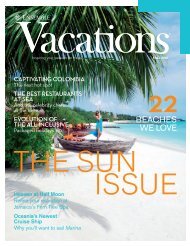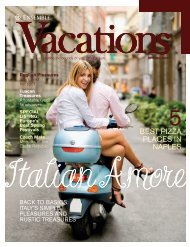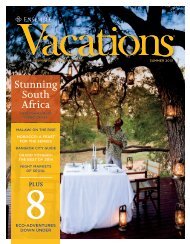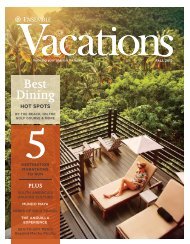Picture - Ensemble Vacations Magazine
Picture - Ensemble Vacations Magazine
Picture - Ensemble Vacations Magazine
- No tags were found...
You also want an ePaper? Increase the reach of your titles
YUMPU automatically turns print PDFs into web optimized ePapers that Google loves.
IMAGE COURTESY OF ANTIGUA & BARBUDA TOURIST OFFICE<br />
Caribbean music is joyful,<br />
passionate and as varied as<br />
the islands themselves<br />
EVERY SOFT, WARM BREEZE IN<br />
THE CARIBBEAN SEEMS TO PULSE<br />
WITH MUSIC. In Jamaica, the slow<br />
and steady bass beats of reggae fill the air.<br />
The lively Afro-Spanish sounds of son can<br />
be heard in Cuba, and in Trinidad and<br />
Tobago, people enjoy the percussive<br />
bell-like tones of steel pan calypso music.<br />
There are many rhythms and blends<br />
of music gracing the islands, including<br />
merengue, salsa, ska, dancehall, reggaeton,<br />
compas, zouk and soca. All are played<br />
with fierce passion and are rooted in<br />
African drumbeats, brought to the<br />
Caribbean by slaves in the 1800s.<br />
On a recent trip to Port of Spain<br />
in Trinidad, I heard calypso piped in<br />
everywhere, from the airport to hotels,<br />
restaurants and bars. It made me hungry<br />
to hear a live band. Walking along<br />
Tragarete Road in the western part of<br />
the city, a mélange of metallic crescendos<br />
caught my ear. Searching for its source,<br />
I came upon the practice yard of the Silver<br />
Stars, a local steel band. Approximately<br />
60 players were standing in front of a<br />
multitude of steel drums, mallets deftly<br />
teasing notes from the pans. They told<br />
me they were practising for Panorama,<br />
Trinidad’s world-renowned steel band<br />
competition that takes place in February,<br />
during Carnival. Scooting into a seat on<br />
the yard’s sidelines, I settled in for a<br />
glorious evening of music. Later, I learned<br />
the Silver Stars won their first large band<br />
championship at Panorama, taking home<br />
the $1 million TTD ($160,000 US) purse.<br />
Calypso was originally a form of protest<br />
music. African slaves were not allowed to<br />
talk while they worked, but they could<br />
sing. Song leaders improvised words in<br />
order to comment on the news of the day.<br />
“The Banana Boat Song (Day-O)” by<br />
Harry Belafonte, popular in the United<br />
States in the 1950s, is an example of the<br />
call-and-response form used in work<br />
songs. The government banned skin<br />
drums in 1884, so inventive Calypsonians<br />
made percussion instruments from<br />
bamboo and created what was known<br />
as tamboo bamboo bands. These were<br />
banned too, and players were left with<br />
stringed instruments, maracas, and<br />
bottles and spoons. In the 1930s they<br />
began to make drums out of metal<br />
shipping containers, paint cans and<br />
garbage cans. By the 1940s they were<br />
using 55-gallon oil drums, which are<br />
still used today. The pan, or drumming<br />
surface, is made of sheet metal stretched<br />
into a bowl-like shape with note patterns<br />
moulded onto the surface. Pans back the<br />
calypso singer, whose lyrics often poke<br />
fun at the rich and powerful.<br />
ENSEMBLE VACATIONS FALL 2009<br />
35












